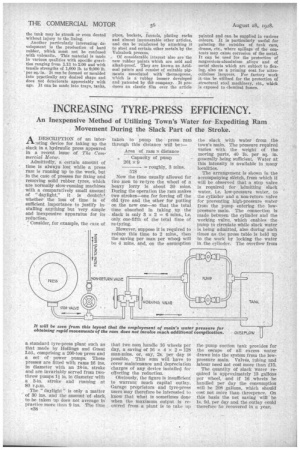INCREASING TYRE-PRESS EFFICIENCY.
Page 22

If you've noticed an error in this article please click here to report it so we can fix it.
An Inexpensive Method of Utilizing Town's Water for Expediting Ram Movement During the Slack Part of the Stroke.
A DESCRIPTION of an inter1-,sting device for taking up the slack in a hydraulic press appeared in a recent issue of The Com-mercial Motor.
Admittedly, a certain amount of time is always lost while a press ram is running up to the work, but in the case of presses for fixing and removing solid rubber tyres, which are normally slow-running machines with a comparatively small amount of "daylight," it is doubtfri 'whether the loss of time is of sufficient importance to justify installing anything but very simple and inexpensive apparatus for its reduction.
Consider, for example, the case of
a standard tyre-press plant such as that made by Hollings and Guest Ltd., comprising a 200-ton press and a set of power pumps. These pressesare fitted with rams 16 ins. in diameter with an 18-in, stroke and are invariably Served from twothrow pumps t in. in diameter with a 3-in, stroke and running at 80 r.p.m.
The " daylight" is only a matter of 30 ins, and the amount 'of slack to be taken up does not average in' practice more than 9 ins. The time 1138 •
taken to pump the press ram through this distance will be Area of ram x distance
. Capacity of pump 201 x 9 — roughly, 3 mins. 578 Now the time usually allowed for two men to re-tyre the wheel of a heavy lorry Is about 30 mins. During the operation the ram makes two strokes—one for forcing off the Old tyre and the other for putting on the new one—so that the total time absorbed in taking up the slack is only 3 x 2 = 6 mins., i.e. only one-fifth of the total time of re-tyring.
However, suppose it is required to reduce this time to 2 mins., then the saving per man per whee4 will be 4 mins, and, on the assumption that two men handle 16 wheels per day, a saving of 16 x 4 x 2 = 128 man-mins, or, say, 2s. per day is possible. This sum will have to cover maintenance and depreciation charges of any device installed for effecting the reduction.
Obviously, the figure is insufficient to warrant much capital outlay. Garage proprietors and tyre-press users may therefore be interested to know that what is sometimes done when the maximum output is required from a plant is to take up the slack With water from the town's main. The pressure required varies with the weight of the moving parts, 40 lb. per sq. in. generally being sufficient. Water at this intensity is available in many localities.
The arrangement is shown in the accompanying sketch, from which it will be observed that a stop valve is required for admitting slack water, i.e. low-pressure water, to the cylinder and a non-return valve for preventing high-pressure water from the pump entering the lowPressure main. The connection is made between the cylinder and the working valve, which enables the pump to circulate white slack water is being admitted, also during such times as the press table is held up to the work by locking the water in the cylinder. The overflow from the pump suction tank provides for the escape of all excess water drawn into the system from the lowpressure main. Valves, tubing and labour need not cost more than £15.
The quantity of slack water required is approximately 13 gallons per wheel, and if 16 wheels be handled per day the consumption will be 208 gallons, which should cost not more than threepence. On this basis the net saving will be is. 9d. per day and the outlay could therefore he recovered in a year.
































